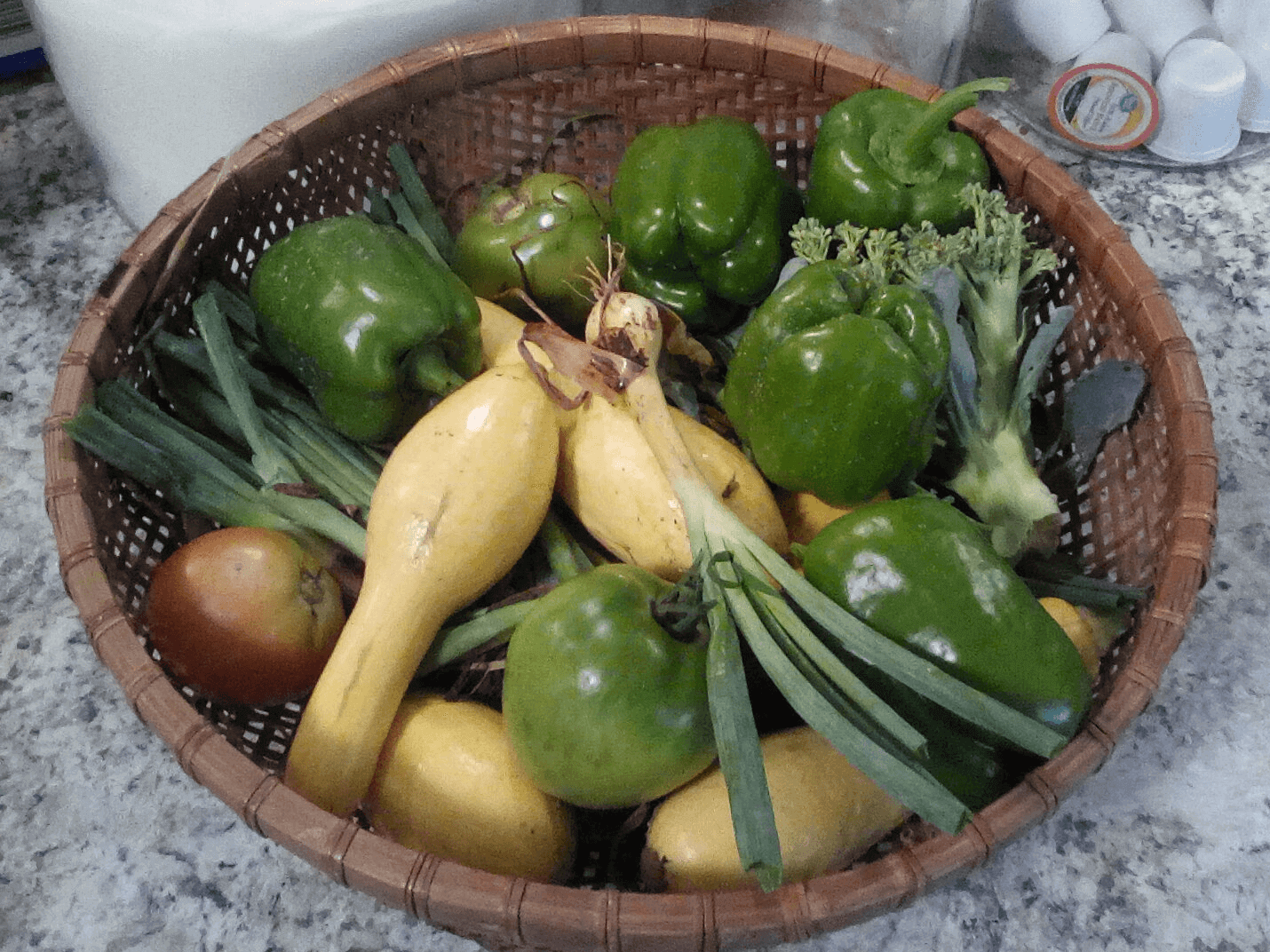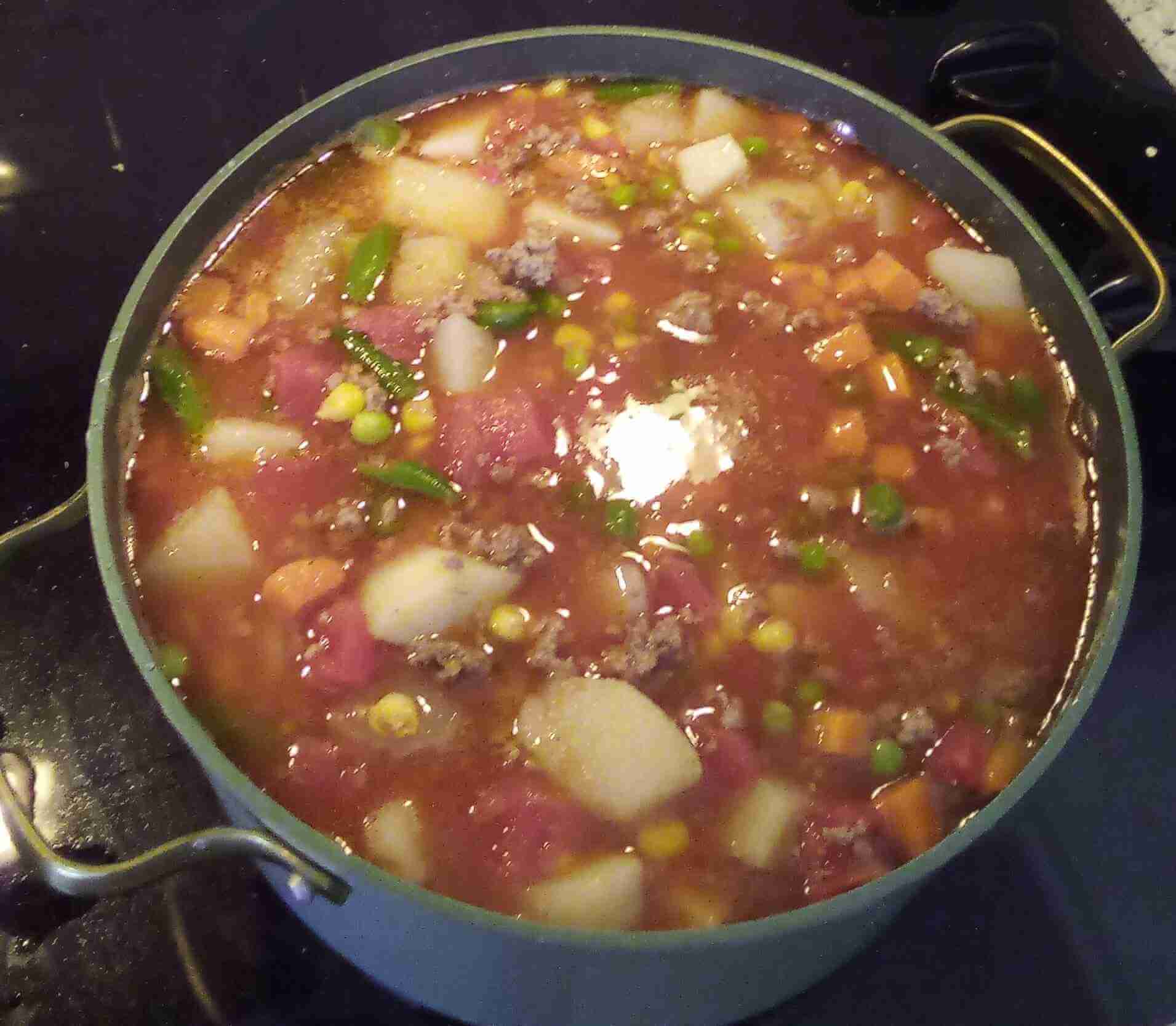
What we have in the associated picture is a basket from a random morning's trip through my family's garden. As these things go it is honestly fairly small,
more a hobby project and way to have a few extra goodies than have an actual sustainable 'we are going to live off the land' mindset. Said garden is,
roughly seventy feet wide by forty long (approximately twenty one meters by twelve for everyone not in the United States). These are not exact
measures and that's somewhat the point. Nothing in a garden is exact at the scale we're working at.
Compare and contrast with GPS guided mega-equipment that works on a fixed schedule with known quantities and strict timing to produce enough
of whatever to stock store shelves, or go on a ship to wherever. This garden falls well short of the calculated acre (roughly four thousand and fifty
square meters,) of land to feed one person using the methods we're using. The most we're doing is tilling to try keeping grass from overgrowing
everything, and occasionally putting down seven dust for bugs and as an anti-fungal. High yield operation this ain't.
Still, it is something I consider worth doing een with the inevetable annoyances and aggrivations associated with continual watering, dealing with
complications, dealing with family whom have differing opinions than mine and whom I can't just ignore, and the inevetable disappointments (such
as an entire row of onions choking out this year, or corn growing shrimpy andp roducing little last year.) I do genuinely wish cities had public spaces
given over to gardening where people are encouraged to help as they want and take according t othe work put in (with any overages going either to
a local food bank, or sold at a local market with any money made getting put back into the garden or to education.) I see this as something worth
doing and making an option for after school activities. Get kids to learn time managment, working in a group, listening to people who know what
the job is, and if al lgoes well they get to eat the literal fruits (and vegetables) of their labor.
After all, take a few precautions we havne't been when planting (putting down anti grass cloth, or paper, or some other barrier, once set up there is a large period of time where not a lot has to be done yet those thigns stil ldo need doing. Gardening is both relaxing, and hectic. It is all a matter of perspective and the company
that is kept while it's going on.

This is the end goal for all that. Well, It is the end goal I'm looking forward to anyway.
James Townsend often does 17th century cooking. Our small garden is, honestly, not enough to live off of. It's annoying when grass chokes
out a row of onions, or the corn stunting, but unlike those nineteenth century farmers we aren't going to die from a bad harvest. Still, even with
the aggrivations? It is both a way to connect with the past, and to appreciate just what goes into the food that goes on one's table.
This, on the other hand, is somewhat undercut bu the fact we have a vibrant amish community in the area and a store where they sell produce
and other goods is ten minutes down the road. Still, while I hate this generational 'raaah kids these days don't appreciate anything' or,
'back in my day,' or whatever argument is used to justify 'my generation is the most awesome,' I view this little garden of ours as a net positive
for my brother's kids, and the kid we've babysat since he was tiny to have that reminder sitting right there in our yard that food isn't to be
taken for granted, and farm fresh produce really does taste better than what you can get at a store ... even if the tomatoes tend to be smaller.
How to make 'Junk Soup.'

This is something mom has made ever since I could remember. Yet I've no memory of my grandparnets on either side of my family making it.
I happen to enjoy it, greatly, so I want to share it with others since it is fairly easy and filling.
If you're going to add meat, this is when yo ucook and drain it.
When we use ground hamburger we go with 70/30, mostly because it's cheaper than lean, but also because the fats will help mellow out
the tomato base. Typically I will cook half a finely chopped onion in with the meat, but that can be added after if you wish. Add seasoning
here to the meat after draining. We use a simple salt/black pepper. Nothing fancy or over the top let the food 'speak for itself' rather than
try overwhelming it with seasoning.
Add in whatever vegetables you have on hand.
While 'Whatever' works? We go with carrots, potato, and green peas or green beans as a base. Everything above and beyond is bonus,
though I will note that when chopped to your favored consistancy; okira, cellery, and are genuinely good fill materials.
After combining the meat and vegetables add in your liquid base.
This is either a quart or two of tomato with or without chunks, or a quart of tomato liquid with beef broth. The goal here is to get enough
liquid in to mostly submerge the solid ingredients, but not completely cover. Though if you do completely cover it's not the end of the world.
Either cook for a little longer to simmer the liquids down, or straight out what you want of the solids and add liquids in your bowl.
Bring up to a boil and stir periodically before lowering the temperature down to a low simmer.
The time here is inexact, and i sadly can offer no better advice than 'a few minutes' for the boil. Stiring is largely to prevent anything from scorching,
as if left unattended the solids will all settle. a lid for your pot is recommendedh ere but not required.
Let simmer either until you're happy with consistancy or if it's close to time to eat then remove from heat.
Again, I can't give exacts here. Just remember unless you literally burned anything in the soup or set something on fire, it is OK. don't beat yourself
up if it is less than perfection. Congradulate yourself. You made Soup.
Enjoy!

 This is the end goal for all that. Well, It is the end goal I'm looking forward to anyway.
This is the end goal for all that. Well, It is the end goal I'm looking forward to anyway.  This is something mom has made ever since I could remember. Yet I've no memory of my grandparnets on either side of my family making it.
I happen to enjoy it, greatly, so I want to share it with others since it is fairly easy and filling.
This is something mom has made ever since I could remember. Yet I've no memory of my grandparnets on either side of my family making it.
I happen to enjoy it, greatly, so I want to share it with others since it is fairly easy and filling.